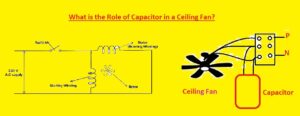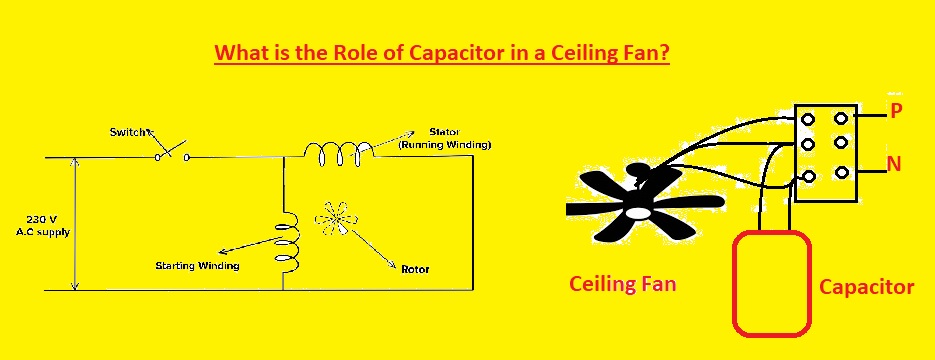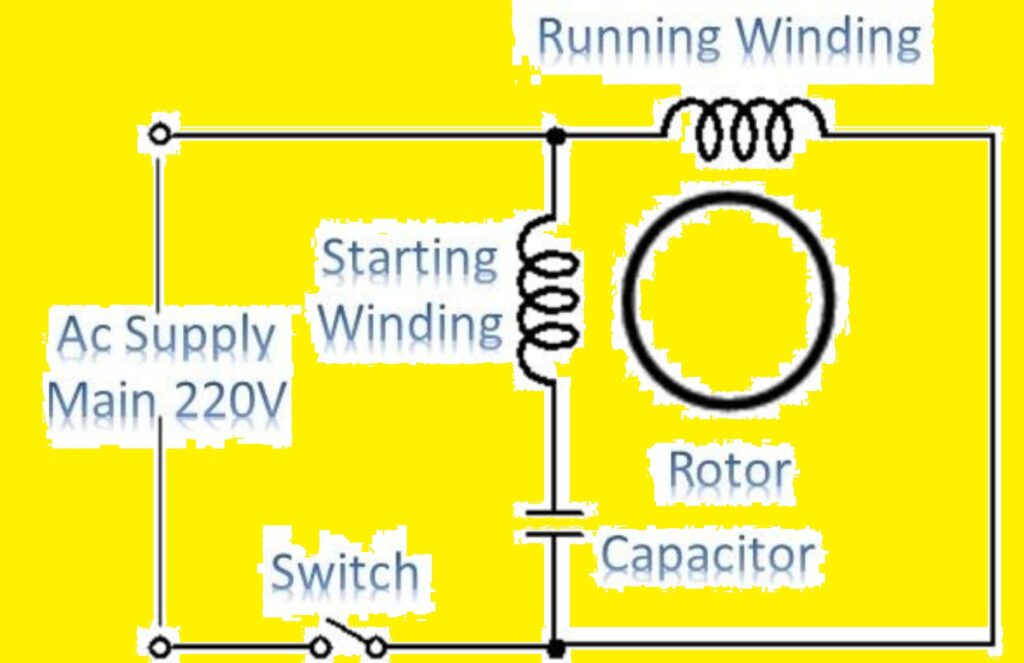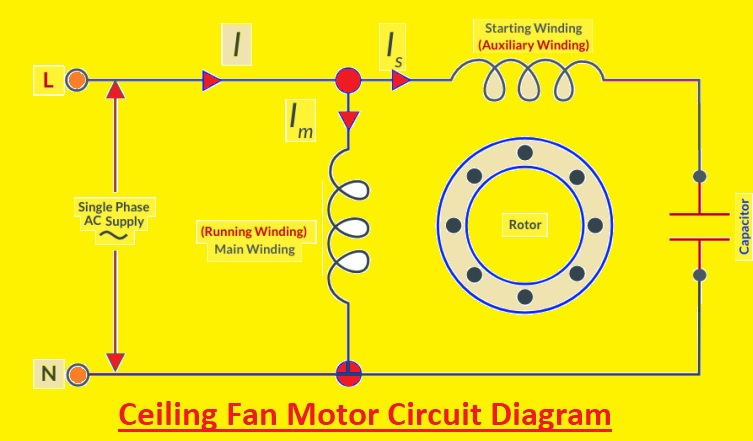 Hello readers welcome to the new post. In this post, we will have a detailed look at What is the Role of a Capacitor in a Ceiling Fan. The capacitor provides the requried starting torque to the fan motor, making sure it smoothly starts and increases efficiency. The ceiling fan is an important component for industries and commercial uses that helps to control temperature and airflow in space.. Here we will get the idea of a Ceiling Fan Capacitor
Hello readers welcome to the new post. In this post, we will have a detailed look at What is the Role of a Capacitor in a Ceiling Fan. The capacitor provides the requried starting torque to the fan motor, making sure it smoothly starts and increases efficiency. The ceiling fan is an important component for industries and commercial uses that helps to control temperature and airflow in space.. Here we will get the idea of a Ceiling Fan Capacitor
What is a Capacitor?
- capacitor is two terminals electrical devices that store enegy if the form of electric charge. It comes with two electrical conductors that part with some distance. The space between conductors is filled with vacuum or with insulating materials called dielectric.
Introduction to Ceiling Fan
The ceiling fan is used in our living rooms, bedrooms kitchen. has size of blade span about 36” (900mm), 48” (1200mm), and 52” (1300mm). The main parts of ceiling fans are listed here.
- Stator: Stator is the static part of the fan motor that has two windings. Main windings and auxiliary winding. The shaft holes the stator also called rod pipe.
- Rotor: it is the rotating part of the fan and connected wings to the rotor. In the form of the motor, the rotor is like a squirrel cage rotor with bars of copper or aluminum
- Capacitor: The ceiling fan has a single-phase motor, that is not the self-starting motor. To make the motor self self-starting capacitor is used in series with auxiliary winding.
- Regulator:It is used to control the speed of the fan.
Importance of Capacitor in Ceiling Fan
The capacitor is the main device for the working of the cealing fan motor. It helps to offer the required starting torque to the fan motor and make sure that the fan starts fast and smoothly. The importance of capacitors for fans is explained here.
- The capacitor helps the fan motor to control the inertia of fan blades and causes them to move helping the fan to start fast and smoothly. If there is no capacitor fan can face difficulty starting or also stall causing damage.
- The capacitor protects the fan motor and other parts of the fan from getting damaged. The fan faces difficulty starting or stalls can damage the motor, bearing, etc. increasing the cost of repairing.
- it increases the fan motor efficiency. The fan starts fast and smoothly easily uses less energy produces less heat increases the life of the motor and minimizes energy costs.
- The capacitor also provides reliable operation for fans.
Different Types of Capacitors
- There are different types of capacitors, such as electrolytic, tantalum, ceramic, and film varieties. Each type of capacitor has its features and sues based on functions. The electrolytic capacitor is the comonly used type of capacitor in-ceiling fans.
Role of Capacitor in a Ceiling Fan

In ceiling fan capacitor is used to offer the required starting torque to the fan motor. The capacitor is an important component that stores and releases electrical energy.
It operates by storing the charge of electrical energy on two metallic plates, known as electrodes that are separated through the insulation material. Energy stored in capacitors is measured by capacitance that is measured in microfarads (μF).
When the fan is on, the motor at the start needs more energy to start rotating, when it running, it needs less energy for running. To offer this initial energy boost capacitor releases stored electrical energy to the motor, offering the required torque. In a result, fan motor starts smoothly.
The main role of a capacitor in a fan is to help the motor control the inertia of the fan blades and get motion. Without the capacitor, fan does not start and can stall resulting the damage.
It is good to note that when the fan is running, the capacitor is not needed and the fan motor runs on the power given through the AC line. The capacitor only needed to provide initial starting torque and it disconnected when fan was running
Faulty Capacitor Symptoms
If the ceiling fan capacitor is damaged then the fan will not start or start rotating at a low speed. Damaged capacitors cannot be fixed or repaired. The only thing is to replace the capacitor.
The capacitance of the ceiling fan is about two to 70 microfarad. So check the manual details of a fan before installing capacitors with a fan.
How to Replace a Faulty Capacitor?
- First of all off the power supply from the main breaker in the home db board.
- Remove the faulty capacitor by cutting the wires connected to a faulty capacitor.
- Replace the capacitor by connecting the Red wire to the first terminal of the capacitor and connecting the blue wire with 2nd terminal of the capacitor.
- Now connect red and blue wire place the wire nut and electric tap and insert wire connectors.
- Now connect black from ceiling fan to 2nd slot of wire connectors.
- Connect live and neutral with the power supply. On the main break to test the ceiling fan..
Capacitor value for ceiling fan
- Normally ceiling fan capacitors have a range of 1.5 to 10 μF, with voltae features of 370 V or 440 V. If there is wrong capacitance value capacitors used can cause an uneven magnetic field around the rotor.
| Fan Motor Wattage | Capacitor Size |
|---|---|
| Up to 50 watts | 1.5 to 2.5 microFarad |
| 50 to 70 watts | 3 to 4 microFarad |
| 70 to 100 watts | 4.5 to 6 microFarad |
| 100 to 120 watts | 6.5 to 8 microFarad |
| 120 to 140 watts | 8.5 to 10 microFarad |
| Above 140 watts | 10 to 12 microFarad |
Advantages of Capacitor in a Ceiling Fan
Ceiling fan capacitors’ main advantages are here
- Energy efficiency: The use of a capacitor to control the speed of the fan casues less energy use and decreases the power expenses
- Longevity: By proving the required starting value of torque and speed of the fan capacitor protects the fan motor and increases the operating life of the fan
Capacitor Wiring Diagram for Ceiling Fans
wiring diagram for the ceiling fan capacitor:
- Make the connection of the red wire with the switch of the fan.
- Motor connected with black wire.
- The blue wire is connected to the fan light kit.
- There must be a neutral wire connected with a white wire.
Ceiling Fan Motor Circuit Diagram
Normally ceiling fan motors are split-phase single-phase AC motors. There are two windings in the ceiling fan starting windings and running windings. Starting winding is called auxiliary windings and running winding is called main windings.
In the above circuit diagrams solie phase induction motor in the ceiling fan is connected with a capacitor in series with starting winding. So
A ceiling Fan without a Capacitor
- In some conditions if there is no capacitor connected to the ceiling fan. So in this configuration starting and running windgs are connected in parallel to single phase supply.
- In this condition current flows through winding inductors, it will generate a pulsating magnetic field, then a rotating magnetic field that is used for torque and rotation.
- As a result of a single-phase supply there is one revolving flux that rotates clockwise and then in an anticlockwise direction at the same time.
- The direction of motor rotation varies after each half cycle which casues the rotor to rotate in a clockwise and antilock direction.
- On the basis of double field revolving theory, both torques cancel each other after half a cycle. The resulting rotating magnetic field will be zero, or zero starting torque.
- So ceiling fans and single-phase induction motors are not self-starting motors.
Hunter Fan Capacitor
- Hunter fans are commonly used in ceiling fans since they offer high-quality design and smooth working.
- In the Hunter fan, two capacitors are used as start and run capacitors. The run capacitor controls the speed of the fan and the starting capacitor offers starting torque to the fan.
- On the bases of fan type and capacitors of different sizes used. Some hunter fan uses 1.5 to 2 capacitance values of capacitors
Selecting the Right Capacitor
- The capacitance of a capacitor is measured in microfarads and it defines the energy stored in a capacitor. The capacitance must be enough to offer the required starting torque for the fan motor. The normal range of fan motor capacitors is 5 μF to 50 μF.
- The voltage rating of the capacitor must be according to the voltage supply of the motor. The capacitor has a rating more thatn the voltage rating can damage the fan motor or not work accurately.
- The capacitor has a rating to work on certain values of temperature normally -40°C to +85°C. It good to choose a capacitor that has a rating according to the operating temperature of the fan.
- The physical size of the capacitor supported with space exists in the fan. Some capacitors are larger than others and may not fit in a given space.
How Capacitor Works in Ceiling Fan
The main purpose of a ceiling fan capacitor is to provide starting torque to the motor. The capacitor is an electrical component that can store energy and release it in the form of electrical energy. Its working is based on charge storing of electrical energy on two metallic plates called electrodes that are separated with insulation material.
Energy stored in the capacitor is called capacitance and is measured in microfarad. If the fan is ON the motor initially needs high energy to start rotating, when it is in running form it needs less energy to run. To provide the initial push of energy, the capacitor releases stored electrical energy to the motor, and gives the motor starting torque. It causes the fan motor to start fastly.
The main work of the capacitor is to minimize the inertia of fan blades and move them.
Capacitor rating for ceiling fan
capacitor rating for a ceiling fan is about 1.5 to 10 μF which is also the same for a table fan capacitor value, with a voltage value of 370 V or 440 V. If there is a wrong capacitance value be connected can casues a uneven magnetic field around the rotor.
ceiling fan capacitor value
The ceiling fan capacitor value is 1.5 to 10 μF.
How much ceiling fan capacitor size is required for a ceiling fan?
Mostly ceiling fan capacitor size is 48 inches sweep working on 220 / 230 V used 2.25 mfd as common rating.
When should I replace my ceiling fan capacitor?
Can I run a table fan without a capacitor?
It is required to have one capacitor connected to each single-phase motor of the fan to produce positive magnetic flux. But in the absence of a capacitor, there is a complete shift in magnetic flux for the current cycle that casues a net zero magnetic field that does not rotate the fan.
What happens if we don’t use a capacitor in the fan?
If the capacitor is not connected to the ceiling fan it will not work accurately. The capacitor is the main component of the ceiling fan since it helps to control the speed of the fan. Without a capacitor, the fan does not start or work at different speeds.
Does the capacitor affect fan speed?
When capacitance increases voltage about the capacitor reduces but across the fan motor increases. So the speed of the fan increases. So high capacitance has a high speed of the fan.
What does a bad ceiling fan capacitor sound like?
What does a condenser fan capacitor do?
The AC capacitor is a component within the outdoor condensing unit of an air conditioner or heat pump. It delivers power to the motor driving the air conditioning system. The capacitor delivers an initial energy burst to turn the system on when it’s time for a cooling cycle.
Can the ceiling fan work without a capacitor?
A ceiling fan is a single-phase motor that is not self-starting. For making it self starting capacitor is used in a series combination of auxiliary winding.
What happens when a ceiling fan capacitor goes bad?
if the fan not starting but spins at a slow speed. It means the ceiling fan capacitor is faulty. So it needed to be replaced to provide the starting torque to the motor for the smooth running of the fan.
What does a fan run capacitor do?
The run capacitor uses change to boose curent that gives power to the fan motor.
Can capacitor reduce fan speed?
The capacitor in the fan circuit can control speed through varying phases between voltage and current given to the fan motor. This change in phase shifts of current flow varies the speed of the motor.
How long do ceiling fan capacitors last?
The ceiling fan can work for about twenty years. But it can vary.
Read Also:
- On AC Capacitor Wiring Colors – 2024 Complete Guide
- What is the Difference Between: Ceramic vs Electrolytic vs Tantalum Capacitors
- What is a Capacitor Polarity – Construction, Its Types, Function & Applications
- Electrolytic Capacitor Symbol, Working, Types, Construction & Uses
- Difference Between Capacitor and Inductor
- Introduction to Ultracapacitors, Construction, Applications
FAQs:
What happens when the capacitor goes bad in a ceiling fan?
The capacitor provides starting torque to the fan and sustains constant torque as the fan works. When the ceiling fan capacitor is affected torque is affected, which casues the problems such as slow fan speeds or the fan not starting at all.
How long do capacitors last in ceiling fans?
Normally ceiling fans work for 5 to 12 years.
Can a ceiling fan work without a capacitor?
Without a fan capacitor the magnetic flux shifts completely for every current cycle. it will produce a magnetic field in the fan and fan will not move. This is the reason for using a fan capacitor.
Can I use a capacitor with a higher voltage rating in a ceiling fan?
Always safely connect the capacitor for a voltage less thatn the rated voltage, but not high voltage. It will affect the capacitors
How do I know which capacitor to buy for my ceiling fan?
The capacitor value for the ceiling fan based on motor featues and requried speed. Normally capcitor with value 1.5 to 3 uF is best to use for ceiling fan.










We have had an Encon 6 blade fan for 40 years. Love it. It stoped a few weeks ago. Had to replace the bearings. Now it runs perfect without the blades. Runs on heigh an medium, but not on low. If I let it run on medium for some time and turn on low it will run but slow. Its got a YUHCHANG 4uf+1uf. With a purple wire on one end and a red and brown on the other end. Cannot find one. Have found one 2uf+4uf with blank and yellow and white on the other. Do you think it will work and do I wire it the same way. Thanks